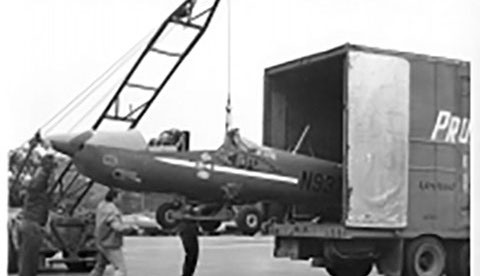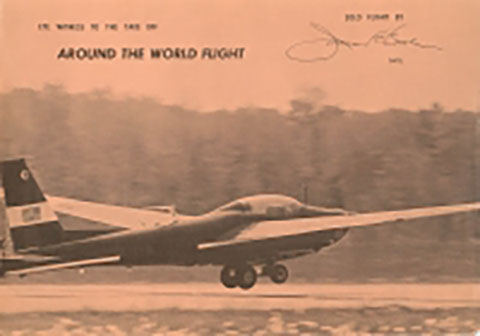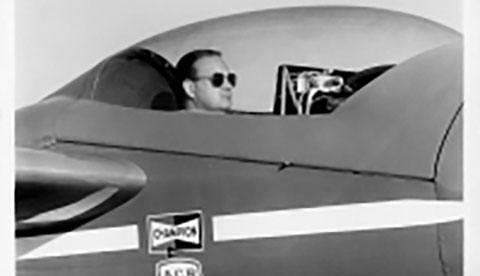The BD-2 is a one-of-a-kind, specially built aircraft. It was built to demonstrate the efficiency of an airplane and its capabilities for long-distance flights. Mr. Jim Bede’s understanding and appreciation for efficient aerodynamics served as his inspiration for this plane. This capability was achieved by implementing a long wingspan and a narrow wing chord (seen on high performance sailplanes) which was fundamental to a high lift to drag ratio. Through the plane’s development, Jim Bede learned that if the BD-2 had enough range to fly around the world, the aircraft would only be required to carry 2.5 pounds of fuel for every pound of dry weight.


The perfect candidate for production was the modified Schweitzer 232 Sailplane, which featured completely sealed wings to carry fuel, a fuselage designed to house a 210 HP Continental IO 360 engine, and two large fuselage tanks installed behind the cockpit, as per his design. The BD-2, or the affectionately named “LOVE 1”, had one other very important and unique feature, the wingtips. These new parts and additions were discovered while trying to find a solution to the problem they had run into; finding enough volume to carry the 565 gallons of fuel necessary. External fuel tanks were quickly eliminated as an option in order to preserve the high lift to drag ratio that the aircraft had. Added fuel volume came in an optional 25 gallon rubber bladder tank, which was installed between the rudder pedals in the cockpit but, the answer came to them through the innovative idea of an extended, reverse tapered wingtip. Cleverly designed in both function and shape, the wingtips allowed the BD-2 to circumvent the issue sacrificing any/all aspects that made this plane great. It improved everything from the efficiency of its flight characteristics, range of the aircraft, and overall wing strength.
The BD-2 used a tricycle landing gear assembly that could be abandoned once the aircraft was sufficiently airborne in order to reduce weight, and would land using a wooden skin fixed under the cockpit, prior to shutting off the engine and feathering the propeller.This situation and airplane was in all sense of the phrase, a powered glider. The aircraft included necessities and luxuries that would improve the quality of flight for the pilot. This included a 25 Liter liquid oxygen container that provided 5 days worth of breathable oxygen, state of the art radios, and a Bendix autopilot system. Jim Bede made the first and all flights of the BD-2 including two long-distance test flights.


The first flight lasted 31 hours and went from Wichita, Kansas to Baltimore, Maryland to Jacksonville, Florida to Miami, then across the Gulf of Mexico to Corpus Christi, Texas, and finally back to Wichita. The second test flight, which lasted 33 hours, started in Cleveland, Ohio and went to Wichita, Kansas, then off to Minneapolis, Minnesota to Green Bay, Wisconsin; across Lake Michigan to Toledo, Ohio; to both Buffalo and Elmira, New York and finally, returned to Cleveland, Ohio during the Labor Day air show at Cleveland’s Burke Lakefront Airport. On November 7, 1969, Jim took off from Port Columbus Airport in Ohio in an attempt to set a new closed course record, which is measured based on the total distance of completed laps. He departed at 8:58 AM Friday to fly to Kansas City, Missouri and back.
After completing nine complete laps, at 3 AM Monday morning the BD-2 lost all electrical power, but was able to make one last radio message to Indianapolis Control Center. He was able to alert operations at Columbus Airport and his flight surgeon Dr. Charles Billings. Three others rendezvoused mid-air with Jim and guided him safely back to the Toledo Airport. At 7:01 AM Monday morning, he landed, his total time in the air at a total of 70 hours and 15 minutes. The BD-2, with its incredible means of flight, set three world records. First, was the longest solo flight. Second, a new closed course record for any category of propeller driven aircraft of 8974 miles. It broke a B-29 record set in August of 1947 by Lieut. Col. Lassiter. Lastly, it broke the record for a closed course for that weight category. He took off with 451 gallons, which was the same amount of gallons the used by Lindberg on the flight to Paris, and completed it with a 121 gallons remaining. All 3 are testaments to the engineering and efficiency of the BD-2’s design.

Crew: 1 Length: 27 ft 7 in (8.41 m)
Wingspan: 63 ft 0 in (19.20 m)
Wing area: 192 sq ft (17.8 m2)
Aspect ratio: 20.7:1
Empty weight: 1,725 lb (782 kg)
Max takeoff weight: 5,600 lb (2,540 kg)
Powerplant: 1 × Continental IO-360C air-cooled six cylinder, 230 hp (170 kW)
Cruise speed: 156 mph (136 kn; 251 km/h) at max take-off weight, 108 mph (94 kn, 174 km/h) at 2,200 lb (998 kg)
Stall speed: 62 mph (54 kn; 100 km/h) at 1,900 lb
Never exceed speed: 194 mph (169 kn; 312 km/h)
Range: 20,500 mi (17,814 nmi; 32,992 km) estimated, still air
Endurance: 120 hr (estimated)